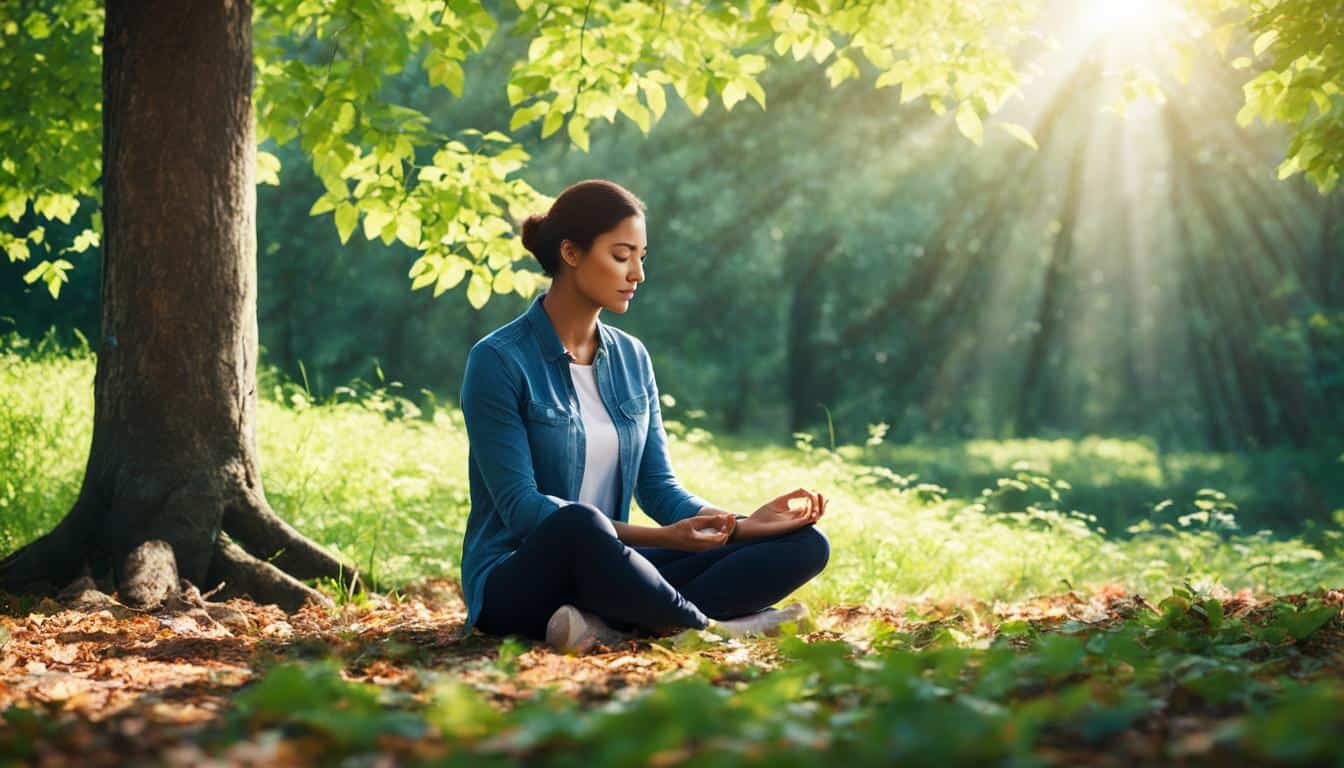Stress and anxiety have become a constant part of our lives, making it challenging to find moments of peace and relaxation. However, by incorporating guided meditation for relaxation techniques into your daily routine, you can experience a profound sense of calm and inner well-being. Guided meditation offers an effective way to quiet your mind, ease your stress levels, and find inner peace.
Key Takeaways
- Guided meditation for relaxation is an effective way to reduce stress and anxiety.
- Through guided meditation, you can quiet your mind and find inner peace.
- There are various techniques and approaches to guided meditation, such as mindfulness and visualization.
- Creating a peaceful meditation space and incorporating guided meditation into your daily routine can enhance your relaxation experience.
- Guided meditation apps and resources can offer additional support for your relaxation journey.
Understanding the Power of Guided Meditation
Guided meditation is a form of relaxation that involves a trained professional directing your thoughts as you meditate. This practice has become increasingly popular in recent years due to its effectiveness in promoting mental and physical well-being. When you participate in guided meditation for relaxation, you can achieve a deep sense of calm that is difficult to attain otherwise. This practice allows you to relax your body and mind, reduce stress, and achieve a greater sense of inner peace.
With guided meditation, you can learn how to focus your mind and achieve a calm state, even in the midst of chaos and stress. By following a structured program led by a professional, you can experience numerous benefits such as improved mood, reduced anxiety, and increased well-being. Whether you are new to meditation or a seasoned practitioner, guided meditation for relaxation can help you achieve your goals and experience deep relaxation.
Guided meditation has the power to promote relaxation and reduce stress both physically and mentally. It can help you stay focused, balanced, and connected to your inner peace. By incorporating guided meditation for relaxation into your daily life, you can experience the profound benefits of relaxation and achieve a state of inner calm and well-being.
Exploring Different Types of Guided Meditation
Guided meditation comes in various styles each with unique features that provide a relaxing and rejuvenating experience for your mind and body. In this section, we will cover some of the most popular guided meditation techniques that you can try to enhance your relaxation practice and reap the benefits of increased tranquility and inner peace.
Mindfulness Meditation
Mindfulness is a type of meditation that helps you focus on the present moment by calming your mind and slowing down your thoughts. During mindfulness meditation, you will be guided to pay attention to your breath and to observe your thoughts as they come and go without judgment or resistance.
Visualization Meditation
Visualization meditation or guided imagery involves creating a mental image that guides you into a peaceful and relaxing state. A meditation guide will prompt you to imagine yourself in a serene setting, whether it be a mountain top, beachfront, or a lush green forest.
Body Scan Meditation
Body scan meditation is all about tuning in to the sensations felt in different parts of your body. The meditation guide will lead you through a series of body scans to help you identify areas of tension and release them through deep breathing and relaxation techniques.
These are just a few examples of the various types of guided meditation available to help you achieve maximum relaxation and inner peace. Experiment with different techniques and find the ones that resonate with you and your meditation practice.
The Benefits of Guided Meditation for Relaxation
Guided meditation offers numerous benefits for relaxation, making it the perfect tool to find peace amidst the chaos of life. Not only does it help reduce stress and anxiety, but it also promotes improved sleep, enhanced focus, and increased self-awareness.
With the help of a guided meditation, you can learn relaxation techniques that will allow you to calm your mind and body and find relief from stress. By practicing guided meditation regularly, you’ll experience deep relaxation and be able to enjoy the sense of calm and well-being that comes with it.
Consider incorporating guided meditation into your daily routine and watch as your relaxation and overall mental state improves. With consistent practice, you’ll gain a better understanding of yourself and your inner thoughts, leading to a deeper connection with your mind, body, and spirit.
Getting Started with Guided Meditation
Are you new to guided meditation for relaxation, stress relief, or anxiety management? Here are some tips to help you get started.
First, find a quiet and comfortable place where you can sit or lie down for the duration of the meditation. Use pillows or props to support your body if necessary, and create a peaceful ambiance by dimming the lights or playing soothing music.
Next, choose a guided meditation resource that resonates with you. There are many options available, such as apps, websites, and audio recordings. Look for a guided meditation that focuses on your specific needs, whether that be relaxation, stress relief, or anxiety management.
When you begin the meditation, focus on your breath and allow yourself to become fully present in the moment. Follow the guidance of the meditation and allow yourself to relax and unwind.
Remember, guided meditation is a practice that requires patience and consistency. Start with shorter meditations and gradually increase the duration as you become more comfortable. Making guided meditation a part of your daily routine can help you experience the profound benefits of relaxation and achieve a state of inner calm and well-being.
Creating an Optimal Environment for Relaxation
When it comes to guided meditation for relaxation, creating a serene environment can make a huge difference in your experience. To enhance your relaxation experience, it’s crucial to create a peaceful ambiance that enables you to focus solely on the meditation.
The first step is to find a quiet and comfortable place where you won’t be disturbed. Next, ensure that your electronics are turned off or on silent mode so that you won’t get distracted by notifications. It’s also essential to keep the lighting in the room soft and dim; using candlelight or a salt lamp is often a great option.
Finally, consider incorporating calming scents into your meditation environment, either through essential oils or incense. You can choose from scents like lavender, rose, or sandalwood. These scents can help activate the relaxation response and promote a deeper sense of calmness.
Techniques for Deep Relaxation
During guided meditation, it’s possible to achieve a state of deep relaxation using various techniques. By exploring breathwork, progressive muscle relaxation, and body awareness exercises, you can enhance your relaxation experience and achieve a sense of inner calm and well-being.
Breathwork
Deep breathing is a powerful technique that can help you calm your mind and reduce stress. Try inhaling deeply through your nose for a count of four, then exhaling slowly through your mouth for a count of six or eight. Focus your attention on your breath, and repeat for several minutes.
Progressive Muscle Relaxation
This technique involves tensing and relaxing specific muscle groups in your body, one at a time. Start by tensing the muscles in your feet and holding for a few seconds, then release and relax. Move up your body, repeating the process for each muscle group. This exercise can help release physical tension and promote relaxation.
Body Awareness Exercises
Body awareness exercises involve scanning your body and focusing on how it feels. Lie down in a comfortable position and take slow, deep breaths. Start at the top of your head and focus on any areas of tension or discomfort. Breathe into these areas and visualize them relaxing and releasing tension. Move down your body, focusing on each area in turn, until you reach your toes.
With these techniques for deep relaxation, you can elevate your guided meditation practice and find deeper levels of tranquility and inner peace. Try incorporating one or more of these methods into your next meditation session and notice the difference it makes.
Incorporating Guided Meditation into Daily Life
Now that you understand the benefits of guided meditation for relaxation and stress relief, it’s time to make it a part of your daily routine. Start small by setting aside just a few minutes each day to practice. As you become more comfortable, gradually increase the duration of your meditation sessions.
It can be helpful to establish a consistent time of day for your practice. Whether it’s first thing in the morning or right before bed, setting a regular schedule can help you build a habit and stay consistent.
Create a peaceful meditation space in your home where you can relax and escape distractions. This can be as simple as a comfortable chair or cushion, soft lighting, and calming aromas.
There are many resources available to help you incorporate guided meditation into your daily life, including meditation apps, online videos, and guided meditation programs. Find the ones that work best for you and stick with them.
Overcoming Obstacles in Guided Meditation
Guided meditation for relaxation can be a transformational experience. However, it is natural to experience challenges and obstacles while trying to achieve a state of inner calm. Here are some strategies to help you overcome common obstacles:
Restlessness
If you feel restless during your guided meditation practice, try adjusting your posture or taking a few deep breaths. Alternatively, you can try a walking meditation to release excess energy.
Wandering Thoughts
It is common for thoughts to wander during guided meditation practice. Try to observe your thoughts without judgment, and gently guide your attention back to your breath or the meditation guide’s words. You can also try using visualization techniques to create a peaceful mental image.
Maintaining Focus
Staying focused during guided meditation can be challenging, especially if you are new to the practice. Try to find a comfortable and quiet environment, eliminate distractions, and set a timer to help you stay on track. You can also try using a mantra or focusing on a specific body part to help maintain focus.
Remember that guided meditation takes practice and patience. By using these techniques, you can overcome obstacles and continue to deepen your relaxation practice.
Guided Meditation Apps and Resources
If you’re looking for additional resources to enhance your guided meditation practice, you’ll be spoiled for choice with a wide range of apps and websites available. Whether you’re a beginner or a seasoned practitioner, these resources can help you find the perfect guided meditation to suit your needs and preferences.
One of the most popular apps is Calm, which offers a vast library of guided meditations for relaxation, stress relief, and more. Another great option is Headspace, which features guided meditations for beginners and more experienced meditators alike. Insight Timer is another excellent app with over 80,000 free guided meditations to choose from.
Other popular websites and online programs include Mindful.org, which offers a wide range of guided meditations and mindfulness resources, and The Honest Guys on YouTube, which provides an extensive collection of soothing audio and visual meditation experiences.
With so many options to choose from, take your time and explore different resources until you find the one that resonates best with you.
Personalizing Your Guided Meditation Practice
Guided meditation is a highly versatile practice that can be tailored to meet your specific needs and preferences. Customizing your meditation can help you to derive maximum benefits and experience a deeper level of relaxation.
You can start personalizing your guided meditation practice by choosing themes that align with your intentions. For instance, if you want to alleviate stress, you can opt for guided meditation for stress relief. Similarly, guided meditation for anxiety and relaxation can be perfect for those grappling with anxiety or depression.
Another way to personalize your meditation practice is by choosing the duration that works best for you. While some people prefer longer sessions of 30-60 minutes, others may opt for shorter sessions of 10-15 minutes. Experiment with different durations to find the one that suits you best.

You may also want to choose a meditation mentor or guide who resonates with you. Many guided meditation apps provide a variety of voices, styles and approaches to meditation. Take some time to listen to a few samples and find a mentor who speaks to you and inspires you.
By personalizing your guided meditation practice with themes, durations, and mentors, you can cultivate a more enjoyable and effective experience. Explore the different options and discover what works best for you!
Conclusion
Congratulations on taking the first step towards a more relaxed and peaceful life! By incorporating guided meditation for relaxation into your daily routine, you can experience profound benefits for your mental and physical well-being.
Remember to take your time and find the guided meditation techniques that work best for you. Explore different resources and customize your practice to suit your individual needs and preferences. With consistency and dedication, you can achieve a state of deep relaxation and inner calm.
Thank you for joining us on this journey towards a more relaxed and stress-free life.



